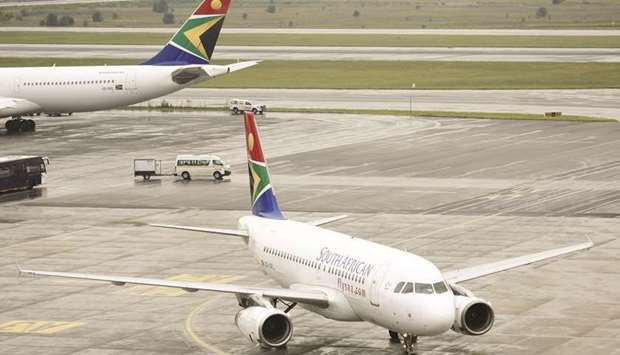South African Airways could receive some of the funding needed to avert its collapse from the state-owned Development Bank of Southern Africa, according to two people familiar with the situation.
While the amount is yet to be decided upon and hasn’t been signed off, the national carrier needs the money to continue operating. SAA has already cancelled some flights this month after the government missed a deadline to provide 2bn rand ($136mn) as part of the terms of its bankruptcy protection.
Spokespeople for South African Airways and DBSA couldn’t immediately comment. They said they may respond later.
SAA has been loss-making since 2011 and has survived on government bailouts and state-backed guarantees on external loans. Its business-rescue experts have until the end of next month to provide a turnaround plan, but the National Treasury has been reluctant to commit further state funds as part of that strategy.
The DBSA’s mandate is to invest in infrastructure projects in South Africa and the rest of the continent that will help with economic development. The financier can back state-owned enterprises as part of its remit, according to the company’s website.
“In our view it would be no better than taking money straight out of the national revenue fund,” said Alf Lees, a lawmaker for the opposition Democratic Alliance. “The DBSA is a wholly state-owned entity.”
At stake is an airline with more than 5,000 employees, as well as thousands more at suppliers and associated companies, in a country with an unemployment rate of 29%. SAA also flies routes to 21 destinations around Africa and cities further afield, including New York and London.
A South African Airways (SAA) plane taxis after landing at OR Tambo International Airport in Johannesburg on January 18. SAA has been loss-making since 2011 and has survived on government bailouts and state-backed guarantees on external loans.
Green deal law to make EU’s energy shift irreversible
Bloomberg
Brussels
Europe wants to make its goal of becoming the first climate-neutral continent irreversible under a new law that is to be unveiled next month, offering investors the certainty they ask for before backing unprecedented levels of investment.
The climate law will require all corners of the economy to take action and give the institutions co-ordinating the shift the legal authority to act when the promises to deliver are broken, according to Frans Timmermans, executive vice-president of the commission.
“This is an exercise in disciplining this transformational age,” Timmermans told a conference in Brussels yesterday. “Transforming a society that is entirely based on carbon to a society that no longer needs carbon as a fundamental basis for its functioning is of a tectonic nature.”
The remarks are meant to build support for the package due on February 26 and to give groups with a stake in the issue a sense of the scale of the project.
The industry is already working on technologies such as carbon capture and storage or hydrogen, and for companies it’s no longer a question of climate targets but of how to ensure the necessary funds for the unprecedented overhaul, according to Marco Mensink, director general of the chemical industry association Cefic.
“I’ve been in Brussels for 15 years now, and I think that people in the room agree we’ve never been in as an exciting moment as we are right now,” Mensink told the conference on the climate law. “That is a 1tn euro or more market opportunity if we get it right; it’s also an enormous investment that has to come to Europe.”
The measures would enshrine in law the Green Deal, a far-reaching strategy to eliminate greenhouse gas emissions by the middle of the century. The shift is at the heart of the agenda of European Commission President Ursula von der Leyen and will affect areas from energy production to transport and agriculture.
The deal is aimed at putting Europe in sync with the objectives of the Paris Agreement on climate change. It would also entrench Europe’s leadership on the environment, putting it ahead of major polluters including China, India and Japan, which have yet to translate their voluntary Paris pledges into binding national measures. US President Donald Trump wants to withdraw from the Paris Agreement.
“This is an epic challenge,” Timmermans said. “It’s also an incredible opportunity for Europe to lead. If we get it right, I can assure you that worldwide there will be huge interest in studying our idea for the climate law. I get questions about this from all parts of the world.”
The climate law requires support from member states and the European Parliament. It will make the 2050 climate neutrality goal binding and may include hints on the trajectory for the bloc to get to zero net emissions.
Von der Leyen signalled she wanted to toughen the 2030 emission-reduction goal to 50% or even 55%. The target is currently to cut pollution by at least 40%.
The commission is likely to stop short of proposing a new target for 2030 at this stage, waiting with more details until the second half of this year when it’s due to publish an analysis on tougher climate goals. That’s set to create friction with the European Parliament, which is adamant that the new law include a 55% reduction target for 2030.
Legislative work on the new climate law is set to last several months. Croatia, which is chairing meetings of member states in the first half of 2020, wants national governments to agree on their common negotiating position in June.
The European Parliament’s environment committee may approve a stance on the law in June, its chairman Pascal Canfin told the conference yesterday. The committee’s decision could be followed by a plenary vote in mid-July, he said. Only then can the two institutions start discussions about the final shape of the law.
While Europe is ready to bet its future on the environmental clean-up, the costs of the transition are dizzying. Reaching the existing climate targets will require additional spending of €260bn ($286bn) annually, according to commission estimates. The commission earlier this month unveiled a sustainable investment plan to help mobilise at least 1tn euro over the next decade to help the green shift.

Smoke rises from the chimneys of a waste incineration plant in Saint-Ouen on the outskirts of the French capital Paris (file). The green deal is aimed at putting Europe in sync with the objectives of the Paris Agreement on climate change.


